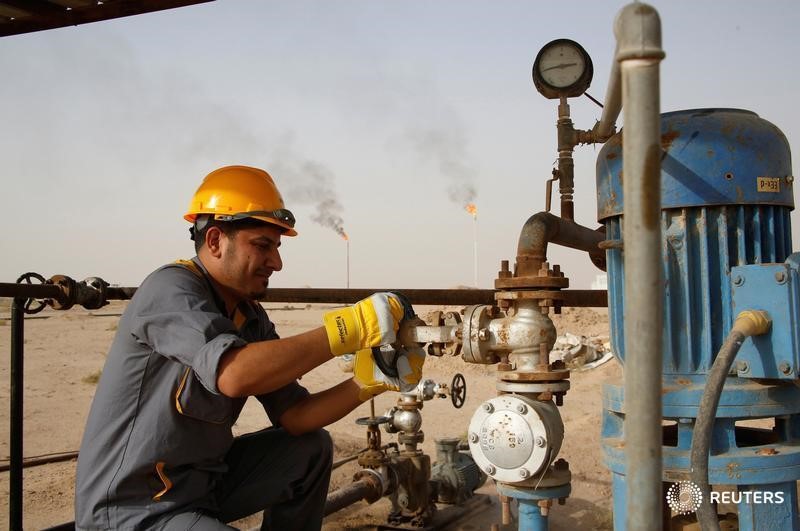* OPEC likely to loosen supply curbs at Friday meeting
* Saudi Arabia, Russia look set to increase output
* China, big buyer of U.S. crude, threatens oil import duties
* U.S. shale output seen at record 7.3 million bpd in July - EIA (Updates with settlement price, adds U.S. shale output forecast)
By Jessica Resnick-Ault
NEW YORK, June 18 (Reuters) - Oil prices rose on Monday in volatile trade as market participants lowered their expectations for how much OPEC might increase production and investors assessed the impact of a trade dispute between the United States and China.
U.S. crude oil CLc1 rose 79 cents a barrel to settle at $65.85. The contract traded at a two-month low of $63.59 early in the session. Brent crude LCOc1 jumped $1.90 to $75.34 a barrel.
U.S. crude's discount to Brent WTCLc1-LCOc1 widened to as much as $9.75 a barrel, after narrowing on Friday.
China imposed import duties on U.S. products on Friday, and suggested that crude oil tariffs were planned. could leave growing volumes of U.S. crude from shale without a buyer, traders said. While the volumes would ultimately get shipped elsewhere, absent China the price could be depressed, traders said.
Meanwhile, the Organization of the Petroleum Exporting Countries (OPEC) and allied oil producers including Russia meet on June 22 in Vienna. Russia and OPEC kingpin Saudi Arabia are pushing for higher output. May, Brent hit a 3-1/2-year high above $80 a barrel, but has since slid on reports of the potential production increases.
"Volatility is going to be pretty high this week," said Bob Yawger, director of energy futures at Mizuho in New York. Indications from OPEC members and other large producers on the scale of potential output increases are likely to drive the market, he said.
Russia and Saudi Arabia have put forward a proposal to increase production from OPEC and non-OPEC countries by 1.5 million barrels per day, Ecuador's oil minister said on Monday. OPEC's second- and third-largest producers, Iraq and Iran, have said they would oppose steep output increases as it would breach previous agreements to keep production cuts in place until the end of the year.
The market traded higher on expectations that the production increases could be less than the full 1.5 million bpd, at 300,000 to 600,000 bpd, said Gene McGillian, director of market research at Tradition Energy in Stamford.
Supply disruptions in Venezuela and Libya also supported the market, he said.
Venezuela's state oil company Petroleos de Venezuela has seen its operations mired by problems ranging from fast-declining crude production and poor refining due to a lack of equipment, to obstacles for exporting oil amid port congestion and financial sanctions. National Oil Corporation (NOC) said storage capacity at Ras Lanuf port had been cut by 400,000 barrels after a second crude oil tank was set on fire amid fighting between rival factions for control of two key export terminals. output from U.S. shale has stoked worries about potential oversupply, however. Five U.S. shale executives were set to speak at the OPEC seminar this week, but three, including Continental Resources Chief Executive Harold Hamm, have withdrawn. crude production from major shale formations is expected to rise 141,000 barrels per day (bpd) in July from the previous month to a record 7.34 million bpd, the U.S. Energy Information Administration (EIA) said in a monthly productivity report on Monday. potential downward pressure from large producers increasing output, Goldman Sachs (NYSE:GS) maintained its bullish outlook. The bank said "the oil market remains in deficit ... requiring higher core OPEC and Russia production to avoid a stock-out by year-end". bank said it expected OPEC and Russian output to rise 1 million bpd by year-end and another 0.5 million bpd in the first half of 2019.
Societe Generale (PA:SOGN) said it expects Saudi Arabia, the UAE and Kuwait to increase output by a combined 500,000 bpd beginning in July, and Russia to increase by 200,000 bpd within two to three months.
"The focus will be on replacing Venezuelan losses," the bank said.
Adding extra pressure are global trade tensions. U.S. President Donald Trump last week pushed ahead with tariffs on $50 billion of Chinese imports, starting on July 6, leading China to retaliate with the threatened oil tariffs. more of a threat than anything," said Joe McMonigle, senior energy policy analyst at Hedgeye Potomac Research. "They're trying to gain leverage in a soft spot for Trump to use for other concessions later."
<^^^^^^^^^^^^^^^^^^^^^^^^^^^^^^^^^^^^^^^^^^^^^^^^^^^^^^^^^^^ TECHNICAL CHART-U.S. crude oil futres
https://tmsnrt.rs/2JSn9jv China crude oil imports in March by country
https://reut.rs/2JXIOa6 Chinese monthly imports of US crude
https://reut.rs/2JJUdhT
^^^^^^^^^^^^^^^^^^^^^^^^^^^^^^^^^^^^^^^^^^^^^^^^^^^^^^^^^^^>
